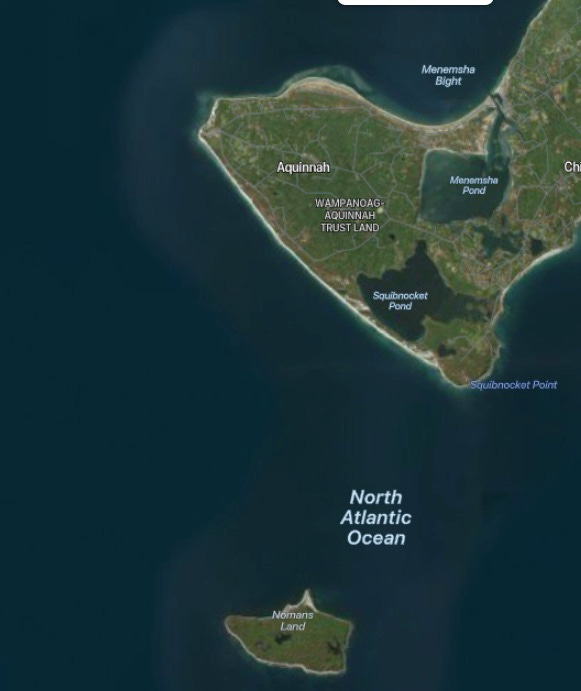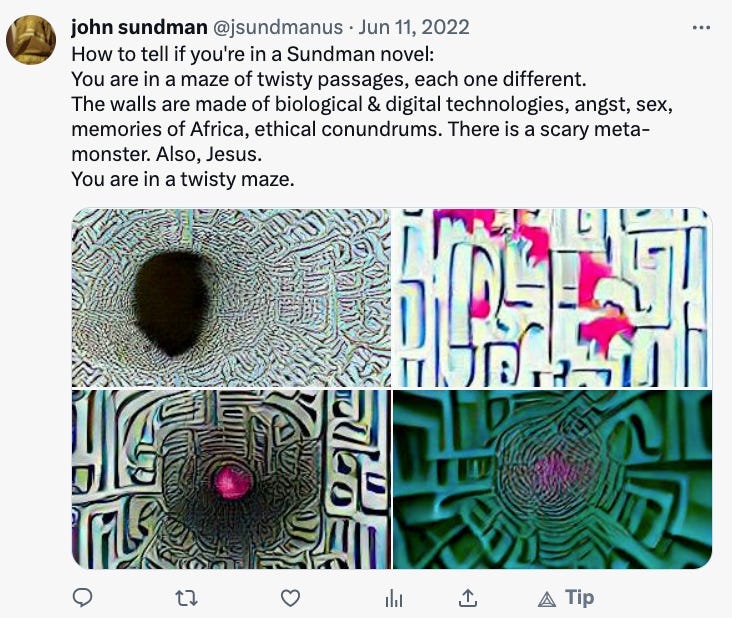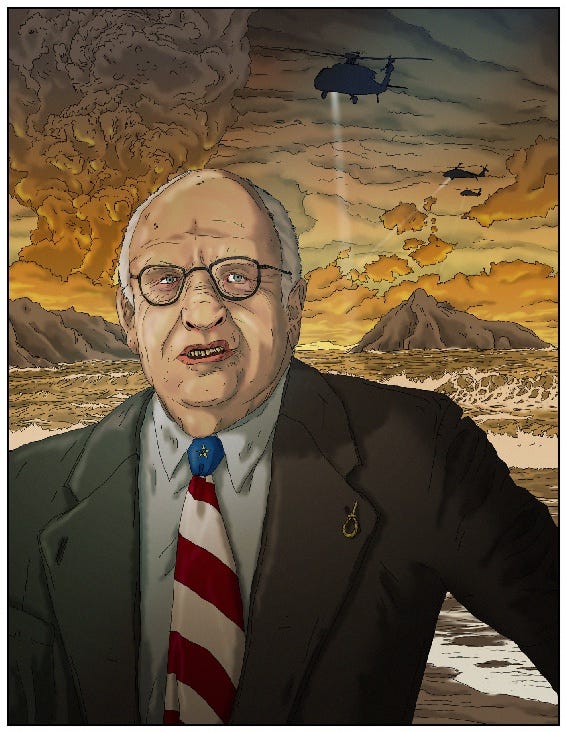Précis
This here Sundman figures it out! post is a mostly spoiler-free discussion of how I’m approaching writing Creation Science, a novel I’ve been wrestling with since before the Big Bang (leaving aside, for now, consideration of whether the phrase ‘before the Big Bang’ is meaningless, since spacetime, hence time, was brought into being by the Big Bang.) It is the complement to my earlier post about my other novel in so-called progress, Mountain of Devils. Like that essay, this one is about my process as a novelist and how I’m approaching various challenges.
I know that some readers of Sundman figures it out! have read all of my books assiduously, that others have read none of them, and the rest of you are somewhere in between. This post is for everyone, whether you’ve read any of my books or not, according to how much the subject of writing novels interests you.
Premises and objectives
When I first began noodling around with Creation Science, sometime around 2009, I had already written and published the cyberpunkish thriller Acts of the Apostles, the metafictional novella Cheap Complex Devices, and the illustrated dystopian phantasmagoria The Pains.
Although each of these books was written in a different style they all dealt in some way with the convergence of biological and digital technologies and with notions of what constitutes a self.
With my next book I wanted to include some of those themes, but also to go beyond them, and I wanted to again attempt a literary form that I had not yet done. At the outset, all I knew about this new book was that it would explore different meanings of the phrase ‘Creation Science,’ including:
the ‘pseudoscientific form of Young Earth creationism which claims to offer scientific arguments for certain literalist and inerrantist interpretations of the Bible’; (and by extension, other creation myths, both ancient and new)
synthetic biology, and the genetic engineering of novel life forms;
the scientific study of human creativity;
cosmology, and in particular the study of the origins of our universe.
I wanted to write a novel unlike any I had yet written and I want to explore new ways of creating it.
In particular, I most emphatically did not want to write another technothriller like Acts of the Apostles.
Nailing Jello to a tree
I didn’t have any characters, or settings, or plot. I didn’t know when the story would take place or how long a time period it would cover. I didn’t know if it would be a satire or a tragedy or a farce or whatever. I just began writing.
Over the last nearly decade and a half of noodling around on this book while working on other projects (Biodigital, Mountain of Devils, various day jobs (construction, freelance technical writing) I had many false starts, lots and lots of drafts that I ultimately discarded.
But eventually a few things began to come into focus:
The action would start on Martha’s Vineyard, the island that has been my home for the last 30 years;
The uninhabited island three miles south of Martha’s Vineyard, called ‘Cappoaquit’ by the Wampanoag people who lived there at the time of the arrival of Europeans and ‘Nomans Land’ by most people today, would be a primary setting for much of the story;
The character known as Monty Meekman — an entity that takes various guises in each of my other books, from the Silicon Valley evil-genius and would-be messiah of Acts of the Apostles and Biodigital to the Beelzebub-like shape-shifting demon of Cheap Complex Devices, and, especially The Pains — would appear;
Noman’s Land would function as a portal to other spacetime dimensions, including those of various myths;
That a main character, perhaps the narrator, would be named Albert Joseph Compton Jr.
The book began to take on a real shape in my mind when I hit upon the time and place of the first scene: the fogged-in construction site of an Internet billionaire’s trophy house near the southwest tip of Martha’s Vineyard on the morning of Saturday, July 17th, 1999, the day after the airplane piloted by John F. Kennedy, Jr, plunged into the sea, killing Kennedy, his wife Carolyn Bessette and sister-in-law Lauren Bessette.
It was easy for me to imagine what it was like on such a construction site on that hot, foggy morning at Squibnocket Point while very loud unseen helicopters hovered overhead somewhere in the direction of Noman’s, because I was there on that very day when the search for Kennedy’s plane commenced, working in a sweltering muddy trench, sweaty and filthy, holding a shovel in my blistered hands.
Later I wrote about it for Salon.
No man’s Nomans
Wikipedia:
Nomans Land (Wampanoag: Cappoaquit; also mapped "No Man's Land," "No Mans Land," or "No Man's island"), is an uninhabited island 612 acres (248 ha) in size, located in the town of Chilmark, Dukes County, Massachusetts. It is situated about 3 miles (4.8 km) off the southwest corner of the island of Martha's Vineyard.
The island was used by the United States Navy as a practice bombing range from 1943 to 1996. In 1998, the Navy transferred the island to the United States Fish and Wildlife Service for use as an unstaffed wildlife refuge, which now forms Nomans Land Island National Wildlife Refuge. Due to safety risks from unexploded ordnance and its value as a wildlife habitat, the island is closed to all public use.
Doesn’t that island just beg for a wacky novel to be set on it? But what kind of novel? How about if a Young Earth creationist somehow gets the rights to build a dinosaurs-plus-Jesus theme park there, amid all those unexploded bombs? What if there’s a massive backlash against it by aboriginal peoples from all over the globe? How about if a Meekman-like genetic engineer has a secret Dr. Moreau-type laboratory on Nomans (its entrance surrounded by bombs)? How about if the Wampanoag legends were true, and Moshup was still out there (among the unexploded bombs)?

How about if JFKjr’s plane crashed into a long-sealed undersea opening to the underworld, like the gate to Hell that Dante stumbled upon “in the middle of our life’s journey” and chronicled in his Inferno? Did I mention all that Nomans Land is covered with unexploded bombs all over the place?

Dante, Ishmael, Slothrop, Albert
Dante’s Inferno is narrated by a poet named “Dante.” Moby Dick has Ishmael. Gravity’s Rainbow has Tyrone Slothrop (sorta, until he just kind of succumbs to entropy).
Creation Science has Albert Joseph Compton, Jr.
Huckleberry Finn opens his eponymous memoir this way:
YOU don’t know about me without you have read a book by the name of The Adventures of Tom Sawyer; but that ain’t no matter. That book was made by Mr. Mark Twain, and he told the truth, mainly.
Similarly, you don’t know know about Albert Joseph Compton, Jr, the real-life model for my character Albert Joseph Compton, jr, without you have read my just-prior Sundman figures it out! post, Albert, unforgotten. If you want more of a feeling about where Creation Science might go, I humbly suggest you go read that post if you haven’t already done so.
But as for exactly how Albert fits into Creation Science, well, you’re going to have to read Creation Science to find out. But first I’m going to have to finish writing it.
Speaking of which, now it can be told: I’m going to have some help with that.
They call him Mister Gibbs
Wasn’t the late, great, Sidney Poitier just totally awesome in In the Heat of the Night?
That doesn’t have anything to do with Creation Science, but maybe it’ll help you remember the name Mark Gibbs (known to some of you geeks as the author of hundreds of hackertastic “Gearhead” articles in magazines like Network World), who I’m introducing today as my co-author.
I think you’ll find the methodology we’ve devised for working together, which I describe in detail below, to be quite intriguing. But first we need to have a talk, you and I.
Let me explain something to you, Walsh. This business requires a certain amount of finesse.
I spend a lot of time writing these Sundman figures it out! essays. Way more than I should, probably, especially given that I’ve made a promise to deliver my new novel Mountain of Devils, along with re-issues of my four existing novel(la)s — in English and Spanish(!!) — before the end of October of this year and I am considerably behind schedule on all of those projects. So why do I do that? Why do I spend so much time constructing these marvelous little essays?
I’ll tell you why I do it, Walsh. I do it to make a more perfect connection to you, to make you see that you’re part of this undertaking with me, so that you’ll hit the “like” button and the “share” button, and leave a comment, and maybe, if you’re not a paying subscriber, sign up for $5 a month, or even, if you’re flush, sign up to be a founding member of Sundman figures it out! and claim in advance your 5 autographed books.
You see, Walsh, my financial future is contingent upon the success of Sundman’s Big Splash(TM), that is, the upcoming release of my new books. Until then I’m hanging on by my fingertips, and if my Big Splash doesn’t succeed I’m hosed. And the success of The Big Splash is largely contingent upon a large and engaged readership of this very substack.
Therefore I need more subscribers — free, paid, founding, it don’t matter. I need more of all of them.
But I can’t grow the readership of this thing without your help. It’s impossible.
So you see, Walsh, you see why I’m a bit concerned? You see why I’m so earnestly asking you to ‘restack’ this essay and tell your friends to read it? Why I’m begging you to hit the fucking ‘share’ button and throw some $$ my way if you can?
OK, Good. Thank you. Thank you for sharing. Thank you for upgrading to ‘paid’. Thank you for becoming a founding member of Sundman figures it out! Let’s proceed.
OK I lied
I’m not going to say anything about how Mark Gibbs and I are planning to work together on this book, other than to say that it involves AI. You’re gonna be amazed.
Promo’s
Sign up for an author’s email list, get a free novel. Both of these promotions offer free downloads of my Biodigital. Please click on one or both images, every time you do helps me, whether or not you choose to signup for anybody’s book.









